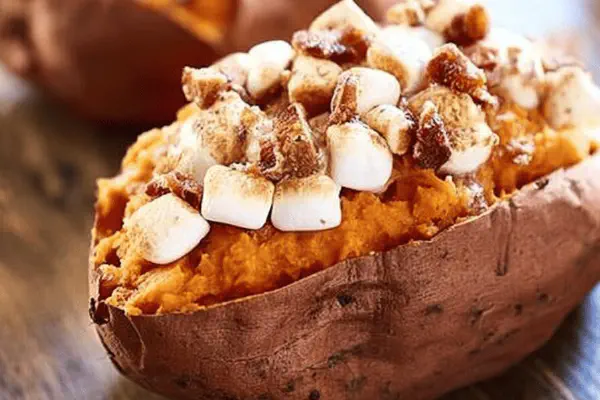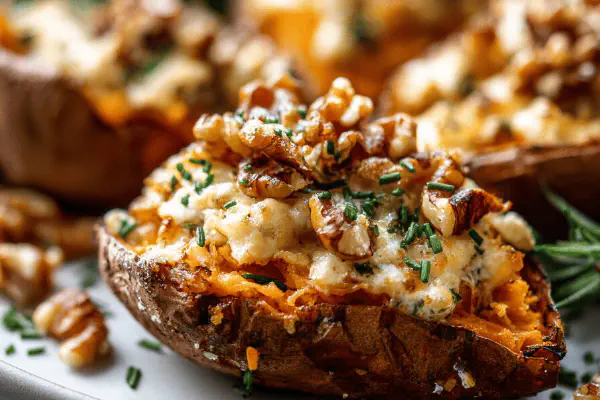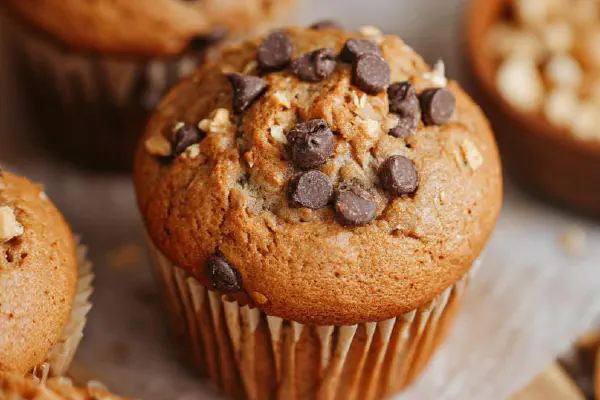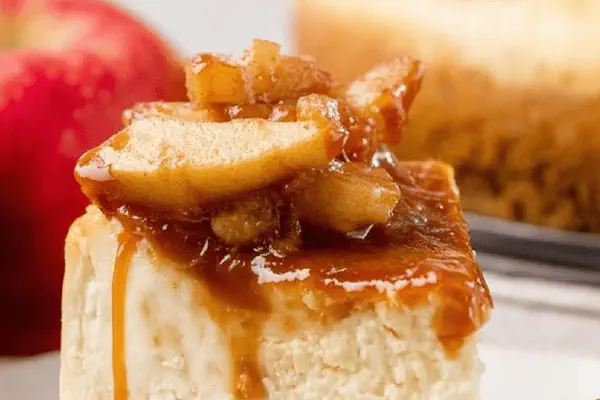Twice-Baked Sweet Potatoes

By Emma
Certified Culinary Professional
Ingredients
- 4 medium sweet potatoes
- 3 tablespoons unsalted butter
- 4 ounces cream cheese (or mascarpone or Greek yogurt)
- 1/2 teaspoon kosher salt
- 1/3 cup light brown sugar, divided
- 1/2 cup chopped walnuts (swap for pecans)
- 1 teaspoon ground cinnamon
- 1 cup miniature marshmallows
About the ingredients
Method
- Start by setting oven to 405°F. Rinse each potato carefully, scrub to remove grit. Lay them spaced on baking sheet lined with foil to catch drips. Slide into oven where heat surrounds. Bake about 55-65 minutes. Test softness by stabbing knife mid-potato—should slide like butter. If firm, return and check every 7 minutes. Smell will sweeten subtly; skins will wrinkly slightly. Let cool until comfortable to touch. Don't rush or scoop hot filling—burns trap.
- While cooling, mix the chopped walnuts with two-thirds of the brown sugar and cinnamon in a small bowl. Keep the remaining third separate; that’ll go on top later. Nuts add crunch and toasted notes, walnuts shift flavor from pecan’s buttery sweet to woodier.
- Slice a slit lengthwise along cooled sweet potato, gently pry open without breaking skin structure. Scoop out flesh carefully with a spoon—avoid tearing skins which hold everything together during second bake. Toss scooped flesh in a medium bowl with butter, cream cheese, salt. Then fold in most of the nut and sugar mixture—this layering of sugar ensures texture contrast, also distributes spices better. Mash just until creamy but retain some chunkiness, makes for interesting mouthfeel.
- Spoon the filling back into the potato skins. Don’t overfill or the skin will crack during bake. Dust each stuffed potato with remaining sugar-nut mix—creates crunchy topping once baked. Return potatoes to baking sheet, slide back into oven for about 15 minutes. Watch edges for slight browning and filling firming—a sign mixture isn’t too wet.
- Pull out, top each potato with about a generous handful of mini marshmallows. Bake again at 400°F for another 5 minutes, keep close—marshmallows should puff and turn golden brown quickly. Avoid overbaking as burnt marshmallow ruins flavor and texture. Serve straightaway while marshmallow crust is soft inside but crisp on top.
- If needed, swap brown sugar for coconut sugar for earthier tone or maple syrup mixed into filling, but reduce liquid butter slightly. For dairy-free, use coconut cream cheese alternative carefully as moisture differs.
- Don’t throw out scooped skins if broken; patch with foil or use for smaller stuffed bite-size snacks baked briefly. The key is to respect heat and moisture balance: overbaking dries filling, underbaking makes it unstable. Smell cinnamon toasted with sugar-touched nuts is good cue for doneness.
- Watch out: spooning while warm might collapse skins, so cool enough but not cold. You want slight softness in filling during final bake to meld flavors. Play with nuts and spices for your own twist; cardamom or allspice swap well in fall versions.
- Scoring skins before first bake helps even cooking but I found it often lets juices escape which dries flesh. Let potatoes stay whole for juicier soft interiors. Practice with potato size affects timing; thin ones cook faster and can crumble if baked too long in step two.
- Use foil on the baking sheet to catch sugars and butter drips—easiest cleanup and stops smoking. Also reduces crust burning below. Don’t skip resting after first bake; it firms potato enough for filling without heat burns.
Cooking tips
Chef's notes
- 💡 Oven temp matters—405°F first bake for crisp skin but soft flesh. Test softness by knife sliding in center. If firm, add 7-minute intervals. Wrinkled skin and sweet aroma help gauge doneness. Don’t rush cooling or scooping—hot filling burns fingers and ruins texture.
- 💡 Divide brown sugar carefully: two-thirds mixed in nuts and filling; last third dusted top for crunch. Layer contrast crucial. Toast walnuts first if possible for smoky notes; swap pecans easily. Keep marshmallows mini size—large ones brown unevenly, risk burnt spots.
- 💡 Scooping? Gently pry lengthwise slit, preserve skin integrity. Tear skins and filling spills, frustrate bake and mess texture. Mash filling creamy but chunk retention adds mouthfeel. Cream cheese variance changes moisture; mascarpone or Greek yogurt needs adjustment to avoid runny filling.
- 💡 Stuffing—don’t overfill skins or filling cracks while baking second time. Watch edges closely, slight browning signals firm base. Marshmallows toast fast at 400°F. Stay near oven, visual cues beat timers here. Puff, golden tops only, or flavor and texture falls flat.
- 💡 Alternatives: swap brown sugar for coconut sugar for earthier tones. Maple syrup in filling needs butter reduction to avoid soggy. Dairy-free? Coconut cream cheese can substitute but moisture varies—test and adjust. Nut allergies? Use toasted pumpkin seeds or sunflower seeds; maintain crunch contrast. Foil-lined baking sheet saves cleanup; parchment if no foil.
Common questions
How to know sweet potatoes are done first bake?
Knife slide in center key. Flesh should feel soft but not mushy. Wrinkled skin and subtle sweet aroma clues. If it resists, put back 5-7 mins, watch closely. Visual shrinkage helps. Timing varies by size.
Can I use bigger marshmallows?
Risk uneven toasting. Miniature marshmallows toast evenly, puff quick. Larger ones burn outsides, stay raw inside. If only large, cut smaller chunks and watch oven. Keep eyes on color; golden all over means success.
What if skins crack during scoop?
Happens if rushed or potato too soft. Cool fully before scooping to avoid spills. Broken skins patch with foil for baking. Smaller skins can be used for bite-size snacks. Avoid tearing else filling leaks and bakes unevenly.
Best way to store leftovers?
Cool completely before fridge. Wrap stuffed potatoes tight or use airtight container. Reheat in oven 350°F till warmed through; marshmallows get soft. Microwave makes marshmallows rubbery. Freeze not ideal due to texture changes.



